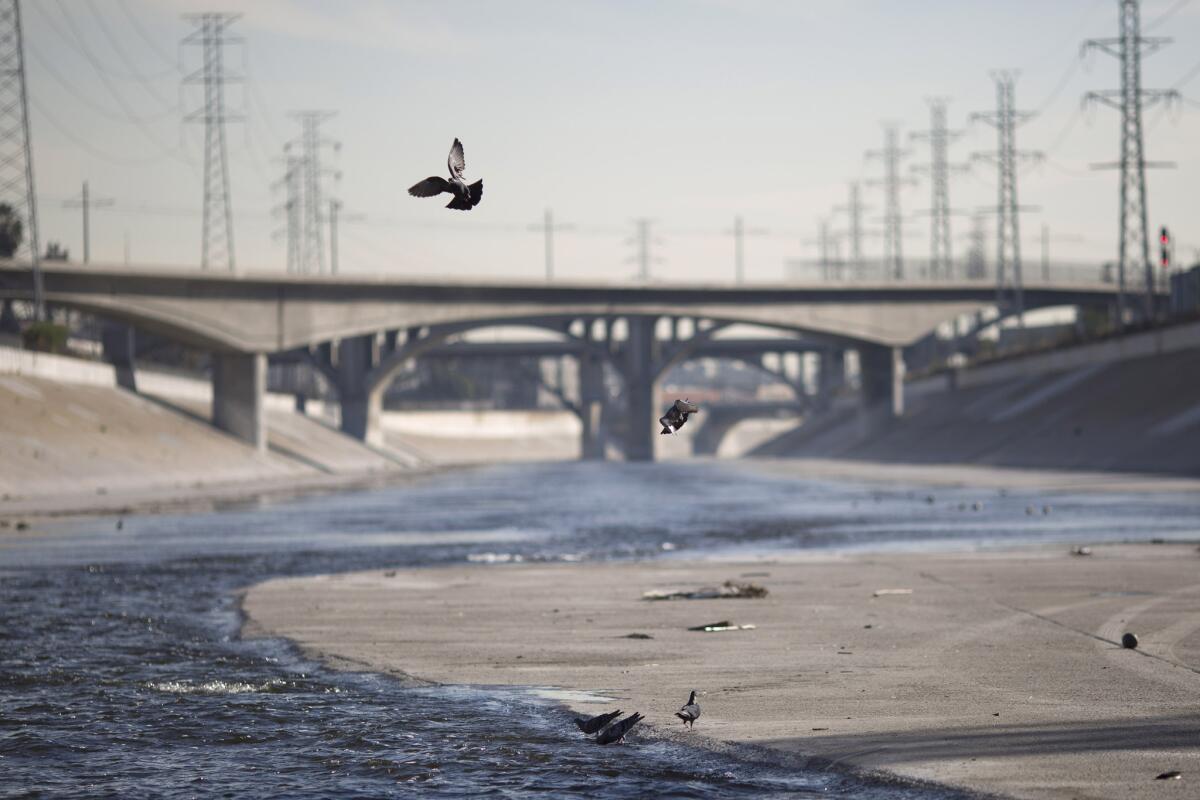Opinion: El Niño isn’t a drought buster -- it’s a missed opportunity

Pigeons fly over the Los Angeles River.
The weather phenomenon known as El Niño tends to mean different things to different people. As a native Angeleno, I associate El Niño with destruction. After all, the 1978 event led to mudslides that closed PCH — which meant I had to take the school bus from Malibu through the San Fernando Valley to Santa Monica High School for months. In 1983, half of the beloved Santa Monica Pier was destroyed by El Niño storms. And in 1997/98, over 40 storms pounded California from December to March.
This year’s impending “Godzilla” El Niño, on the other hand, is being heralded as a savior for California’s water woes. And, indeed, a wet year after the worst drought in California’s recorded history is welcome news. Since the El Niño is classified as very strong by the National Oceanic and Atmospheric Administration, as opposed to merely moderate (like 2003 and 2010), there is a high likelihood that we will have elevated rainfall this winter.
With December storms already sweeping in and bolstering California’s snowpack, the hype over the Godzilla El Niño of 2015-16 is reaching a high note. That said, I suspect future generations of Angelenos will come to remember the 2015-16 El Niño not as a savior (or a destroyer) but as a wasted opportunity.
El Niño-driven storms will definitely provide much needed relief to the state. But they won’t end the drought. And despite the fact we’ve all been waiting for a weather event like this for years, we aren’t actually prepared to take full advantage of it.
Southern California’s water infrastructure still isn’t equipped to capture sufficient rainfall during a wet year. Instead, tens of billions of gallons of water that could have bolstered our local supplies will flow like a torrent through our urban rivers and storm drains. Instead of quenching our thirst, El Niño’s rains will sweep up and carry our pollutants out to sea. With the exception of sites along the upper San Gabriel and upper Santa Ana rivers, we simply haven’t built adequate stormwater capture and infiltration infrastructure.
It’s too late now to take advantage of El Niño. We can’t just flip a switch and capture a large portion of the runoff flowing down the L.A. River. The Sepulveda Basin channels runoff from over 100 square miles, but it is designed for flood control, not to capture and store rainwater. The Tujunga Spreading Grounds can only capture and infiltrate about 8,000 acre feet a year (enough water for about 50,00 people annually). Not bad. But this year’s flows into the Tujunga Wash will probably be at least 10 to 20 times that — possibly even more. In addition, large cisterns on private property are still a rarity, rather than commonplace like in other drought-affected areas like Australia and island nations like Bermuda.
The reality is that despite four years of intense drought, Los Angeles has the same old flood control system it always had, not a water supply system. Stormwater is one of the most inexpensive sources of new, local water that we have in Southern California. We have to do better.
That’s not to say there hasn’t been some progress. Tujunga Wash is in the process of doubling its stormwater recharge capacity. L.A.’s Proposition O funded the construction of a 3-million-gallon cistern at Penmar Park in Venice and another large cistern in the Palisades. And there has been a great deal of effort to inform the public on flood and mudslide risks, which is critical to protecting life and property. Yet major large-scale city and countywide investments for large residential cisterns, for replumbing Sepulveda Basin to capture and transport stormwater to the permeable soils of the east Valley, or for transforming the region’s streets and alleys into green infrastructure that both beautifies communities and infiltrates stormwater, simply haven’t happened.
This winter, every time you drive past the L.A. River and see it gushing with stormwater it should serve as a reminder of our missed opportunity. Investments in stormwater capture and infiltration help reduce coastal and river pollution, reduce flood risk and, most importantly, augment local water supply. Without these steps, L.A. County’s reliance on 58% imported water is unsustainable.
El Niño may very well provide much needed short-term drought relief. But that relief won’t last with our current infrastructure. It’s imperative that we never waste another opportunity like this one again.
Mark Gold is UCLA’s Associate Vice Chancellor of Environment and Sustainability and the lead on UCLA’s Sustainable L.A. Grand Challenge
Follow the Opinion section on Twitter @latimesopinion and Facebook
More to Read
A cure for the common opinion
Get thought-provoking perspectives with our weekly newsletter.
You may occasionally receive promotional content from the Los Angeles Times.






